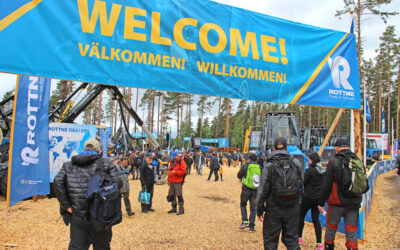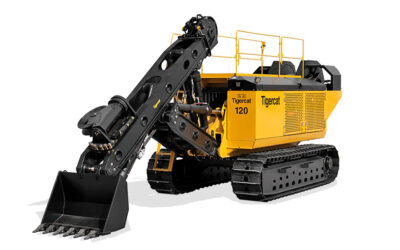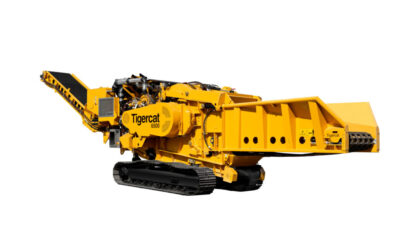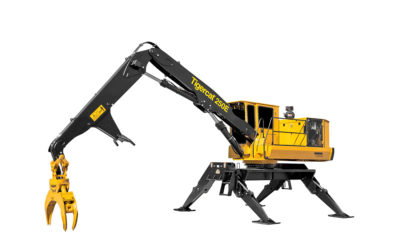GENE CARTER SMILES HIS WAY THROUGH LIFE
Article by DK Knight, Executive Editor/Co-Publisher, Timber Harvesting July/August 2017
It’s always a ‘peach cobbler pleasure’ to visit with Gene Carter, a retired Alabama logger whose friendship is special and who I admire for many reasons, two being his infectious sense of humor and high octane optimistic spirit. Gene must have exited the womb grinning, for with him smiles and laughter bubble up like water from an artesian well. It’s been said that laughter helps make a person live longer, and if true, then he should easily make it to 110.
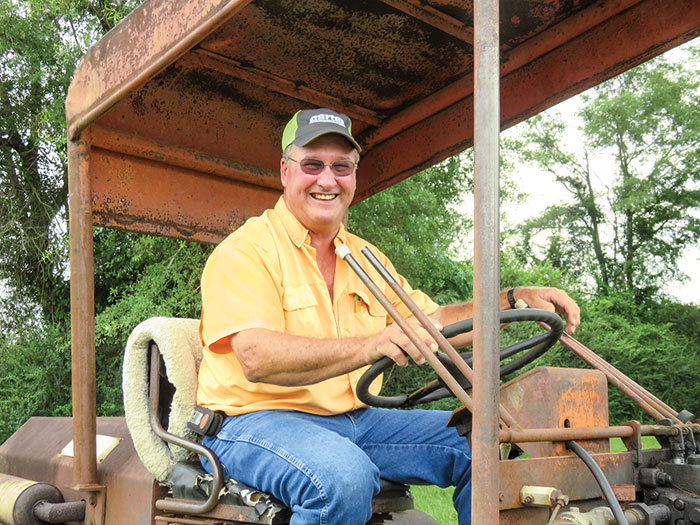
Every time I see him in person or talk with him via Verizon, Gene is happy. He’s the type of person who makes you feel good by simply being around him. He likes to talk, is good at it, and never seems to tire of it. He never meets a stranger, and has a titanic zest for life. I like to kid him that he never encountered a tree he didn’t want to cut, a brand of chewing tobacco he didn’t want to try, or a Dairy Queen he didn’t want to patronize.
Now 69, Gene resides reasonably close to the geographical center of Alabama. To get to where he hangs his hat—he has dozens to choose from, and it strikes me that I might not easily recognize him without one—travel to Clanton in Chilton County, go west on state route 22, proceed through Maplesville, and cross U.S. 82. Not long after you pass the West Fraser sawmill on the right you’ll find yourself on the edge of what’s left of the Stanton community, which borders the southeastern reaches of the western component of Talladega National Forest. At the Ebenezer Baptist Church, turn right on county road 45 and go about a mile and a quarter and look to the right for mailbox number 3504.
Gene told me when I called that he’d be out back under the cover of his shop, where Janet, his wife of 46 years, suggests he visit from time to time on any given day, with Sundays being the possible exception. There he was, enjoying a chew and sitting on a plastic spool of some sort and looking beyond a pile of heart pine logs and stumps, a fuel tank, a stack of spent crossties, and other assorted materials he had not yet brought himself to classify as nonessential.
Rising and extending a firm hand and automatic smile, he asked, “How you doin’? Good to see you.” Pleasantries aside, he got right to it, firing: “Listen!” pointing to the east and cocking his right ear. “That beagle’s been after a rabbit for a half hour. Don’t it sound good? It’d sound better if Flash, my nephew’s red bone hound from across the road, was there to add a little bass. They call him Flip-Flop now. Car hit him and broke his left front leg, and the vet set it and put it in a cast, but it didn’t last any longer than a rainbow. Now that leg just flips and flops, but he’ll still chase a rabbit with a lotta heart.”
It was a fitting backdrop for the figurative rabbit chasing that followed as the day deepened.
The Shop: Collector’s Items, Leftovers
We poked around the shop, sidestepping a Deutz-
Allis farm tractor, golf cart, two smallish motorcycles, and clusters of miscellaneous items left over from his 1966-2014 logging career, and others having no connection to logging at all. There was a pallet of hydraulic oil, a few black trash bags full of soda cans, three tired-looking Stihls, a cooking grill, boxes of this and that, and under some plastic an old cash register and adding machine. “Look at these,” he said of the antiques, batting away some pesky dirt (mud) daubers. “Came from the old store my mama ran when I was growin’ up.”
Looking around, I spotted a dusty bicycle from his boyhood, along with advertising signs, thermometers and clocks, license plates from near and far, and a new bow for a chain saw. There were more dust-covered bags of soda cans in the floored storage area above a closed-off work space and one-time office, prompting me to say, “Gene, these bags were up there when I visited last July, and you told me then they’d been up there for years.”
He chuckled. “Yeah, Janet keeps after me about cleanin’ up out here and throwin’ some of this stuff away, but my ‘round tuit’ ain’t what it used to be. And hey, the price of aluminum might go up again one day.”
Inside his former office there were old magazines, photos, calendars, posters, a wall-mounted peavey, and numerous caps and hard hats, some claimed by the dirt dauber friends of those from beyond the wall. “Reckon these things are out to take over in here,” he said, opening an outside door in an attempt to shoo them away. In doing so he spotted a not so small but occupied guinea wasp nest at the top of the door jamb and, as though he was accustomed to doing so, quickly reached up, pinched it off and threw it to the ground.
In the walled-off work area it was all the more cluttered. He laughed as he recalled an incident from years gone by: “I was lookin’ for something in here one day and pulled out a box from back in a corner under this bench and found a box with a new Husky model 77 saw that I forgot I ever bought.” To this day, it’s still tucked away, in the box, unused.
We ambled back to the shop’s open area and rested our rears on whatever Gene had found for us to rest them on, and I asked about his early years. But before he could begin, his phone chirped. “Come on with it,” he said in a loud voice, and after a few seconds of silence: “The only way you’ll see a Dodge parked in my driveway is if we have company.” The call ended quickly thereafter. He did not elaborate; I did not ask.
Background: Deep Roots
One of four kids born to Lottie and L.M. (Shug) Carter, Gene, older brother Larry and two sisters grew up on the small Carter farm and around their daddy’s peckerwood sawmill and small store, located on a dirt road a mile or so south of Ebenezer church. Their workaholic daddy instilled a resolute work ethic in his sons, who began helping around the mill and attendant log/pulpwood operation at an early age. Gene credits his mother for his beaming personality and glass-half-full outlook. “All daddy wanted to do was work. We got most everything we wanted as teenagers but we had to work before we could play,” he pointed out.
Both Larry and Gene managed to ‘pulpwood’ some during summers while still in high school, using saws, old trucks, mules and/or tractors provided by their daddy, so it was only natural that they would take their efforts full time and go out on their own after receiving their high school diplomas. For Gene, the year was 1966.
“My old English teacher told the principal, ‘If that boy doesn’t start studying he is going to haul pulpwood for the rest of his life.’ Turned out she was right,” he said, grinning. “Pulpwooders and well diggers were in the same category back then, and that’s no disrespect to well diggers.”
Actually, the pulpwood pay in those days was equal to or greater than that of most any other job available in that time and place. Even so, it was grueling, dirty, dangerous work that in the beginning was ruled by chain saws and loading by hand and, needless to say, lots of stamina.
Gene recalls his first truck was a late ’50s Ford single axle that had no driver’s side door or rear cab glass and could haul about three cords. It was common hereabouts and elsewhere in the South for the ‘hands’ to ride to the job seated on the truck frame and at times to ride on top of the load at the end of a long day.
Early Machines
“What brand of saws did you use then,” I asked.
“Homelites, because that’s what daddy had started using earlier. He changed to Home-lites from McCulloughs because he said he wore out a pickup haulin’ them to and from the dealer.”
After trying several types of loading methods/machines, in 1975 Gene purchased his first knuckeboom loader, a well-used Copeland, which he recalled was an underperformer. “That thing was bad about leakin’ at fittings and swivels. I’d catch fluid in a five-gallon bucket and pour it back in the hydraulic tank. I was recyclin’ before recyclin’ was cool,” he recalled. He found himself traveling often to the Copeland plant in Montgomery. “I walked in one time and the lady asked me, ‘What do you need today?’ I told her, ‘I believe I need one of everything you got.’”
Another leaky machine—leaks were commonplace across all brands in the ’70s—he owned was a Timberjack 225 cable skidder. “The control levers in the cab leaked so much you just about had to buy a new pair of boots every six months,” he said. “But the real reason we got rid of it after a year or so was that Hercules winch, which was so weak it wouldn’t pull the hat off your head.”
Gene was always a hands-on logger who kept his operation relatively small, believing that 7-8 loads a day was enough to make a good living while allowing enough time to enjoy his family and to participate in the activities of his two kids, Casey and Kelly, and later their children (two boys each).
He became very safety-conscious across the years, going to orange hard hats and chaps in the late ’80s after an employee cut his knee cap with a saw. He also implemented a profit sharing plan in 1988 and began offering group health insurance program and granting annual paid vacation time. Janet started using a computer in the business in 1989.
Was he ever seriously hurt on the job?
“Not really. I had my share of minor cuts, scrapes and bruises, and I turned over a couple of machines,” he said, pausing and continuing: “Course, I had my feelings hurt many times,” he chuckled.
A Little Carter/Knight History
Gene and I first crossed paths in the late ’80s when I served on a committee that selected the Alabama Logger of the Year. He was nominated in 1989, 1990 and 1991, the year he brought the honor home. That’s when Southern Loggin’ Times, a companion publication to TH, featured his company on the cover. In that account, the writer noted that Gene’s loader operator had been in a serious auto accident and that the employee’s brother had phoned Gene to inform him that the victim was near death. Gene’s reaction: “You can’t let him die; he owes me too much money!”
The man lived to borrow money again.
The next year he and several leading state loggers formed the Alabama Loggers Council and Gene remained active in the group for years.
Gene and Janet were traveling companions with yours truly and my wife, Jane, on several occasions over the years. There were trips to eastern Canada, the Pacific Northwest, and to Arizona-New Mexico—all memorable and filled with laughter. The Canadian trip included a visit to Niagara Falls, which bustled with people from all over the world. On one occasion Gene paused to listen to a man of Middle Eastern descent talking on his cell phone. Afterward, I asked Gene: “What did he say?” His reply: “I believe he said somethin’ about his goat gettin’ out.”
Soon after Casey decided he wanted to take his sideline welding-fabrication business to another level rather than assume his daddy’s logging venture—Casey operated a feller-buncher for his dad for 17 years—Gene decided to pack it in after 48 successful years. He sold his bread-and-butter equipment quickly and eventually parted with everything except a Cat D5 dozer and his oldest and dearest machine, and likely one of the logging industry’s rarest—a vintage Windham HiGrader (model WFDFG 372, serial no. 1765).
His Windham Love Affair
What in the world is a Windham HiGrader? Well, you won’t find it on the Internet with the aid of Google. Some loggers and equipment pushers who operated in the South in the early ’70s will remember it as an odd-looking contraption—many were in that era—a cross between a rough terrain forklift and a small, self-propelled knuckleboom loader. As Gene might say, it kinda looks like it took a long dip in an ugly pond.
The brainchild of sawmiller turned forklift manufacturer Paul Windham, it was a low-cost, rather crudely and simply designed sorter/loader that found favor with small operators working both short pulpwood and logs at a common landing. Windham introduced it in early 1969, offering it for perhaps three years. Later, Windham sold the businesss, and it eventually closed.
Gene bought his HiGrader new in 1972 for something south of $10,000. A year later he had a local mechanic add an open-air cab. He used it as a loader for three years or so, then his daddy claimed it for the sawmill operation when Gene moved to a knuckleboom loader.
Sure, Gene is sentimental about the machine, but primarily he keeps it for its usefulness and versatility. Months ago he used it to unearth the leaky water line between his house/shop/road. Last year he and Larry acted on a short-lived burst of energy and used it to load about six cords of beetle-infested pines they took down with chain saws on Gene’s land. Their energy gave out after three days and they decided to let nature take its course with other dead trees. Gene has used the Windham to move crossties, scrap steel and other bulky stuff, not to mention transplanting 20 ft. saplings.
“It’s rusty and ugly and the seat is gone and the engine is wore out, but it still fires with a touch of the starter,” Gene bragged. “I don’t know just how many times I’ve had people want to buy it.”
Regarding rust, there’s no danger of it getting to Gene any time soon. He no longer starts his day at 3:30 but usually rises by 5. Depending on the season, he cuts grass, trims shrubs, runs errands for Casey, takes local trips with Janet, repairs things, visits with Larry, takes in the activities of grandkids, follows the local football team, and visits with others at a Maplesville saw shop on Saturday mornings and a restaurant around 11 a.m. on Tuesdays and Thursdays.
Accumulated Friendships, Relationships
In terms of dollars, Gene didn’t become wealthy in the woods, although he did very well. Unlike him, that high school English teacher mentioned earlier likely did not have the cash to buy land or invest in a new local bank or eventually occupy a board seat on said bank for 30 years. But what matters most to him are the friendships and relationships he has accumulated.
If he could start over again, chances are he would not change much, if anything. For his success he credits God, his parents, Janet, Larry and Casey, his employees and good markets. “The wood business took me much farther than I ever dreamed it would,” he acknowledged with a twinkle in his eye.
Gene, Janet will fuss when she reads this parting advice, but please don’t clean up too much in and around your shop. If you did that, my visits would never be the same. Many thanks for your sunshine personality and for your special 30-year friendship. Smile on, my friend.
Latest News
Loan Program Aims For Wood Processing Facilities
Loan Program Aims For Wood Processing Facilities TO HELP REDUCE WILDFIRE THREATSU.S. Department of Agriculture (USDA) Secretary Tom Vilsack has unveiled a new program to support American wood...
European Logging Show Elmia Wood Moves To Biennial Event
European Logging Show Elmia Wood Moves To Biennial Event Starting in 2025, Elmia Wood will host its trade fair every two years instead of every four. This change is made possible through a new land...
New From Tigercat: 120 Winch Assist
New From Tigercat: 120 Winch AssistThe new Tigercat 120 cable assist, the second model in Tigercat’s cable systems product line, leverages the company’s deep experience in steep slope harvesting...
New From Tigercat: 6500 Chipper
New From Tigercat: 6500 ChipperTigercat has officially launched 6500 chipper after more than a year of successful field operations involving multiple retail units. The 6500 is a heavy-duty...
Colorado Biomass Power Plant Set For Auction
Colorado Biomass Power Plant Set For Auction Eagle Valley Clean Energy in Gypsum, Colo. filed for bankruptcy in spring 2024, after the facility closed abruptly in November. Officials report an...
New From Tigercat: 250E Knuckleboom
New From Tigercat: 250E Knuckleboom Tigercat has replaced the 250D loader with the new and improved 250E model for tasks such as delimbing, slashing, merchandising and loading trucks. Among other...
Oregon Dept. of Forestry Seeks Operating Loan
Oregon Dept. of Forestry Seeks Operating LoanState forestry officials are seeking changes to the way the state funds firefighting efforts after the agency had to ask the Oregon State Treasury for a...
Yosemite Seeks New Colorado Feedstock Study
Yosemite Seeks New Colorado Feedstock StudyOfficials with Yosemite Clean Energy recently announced a $300,000 grant from the USDA Forest Service Wood Innovation Fund that will support a feedstock...
WANT MORE CONTENT?
Spanning seven decades since its inception in 1952, Timber Harvesting highlights innovative and successful logging operations across the U.S. and around the world. Timber Harvesting also emphasizes new technology and provides the best marketing vehicle for the industry’s suppliers to reach the largest number of loggers in North America and beyond.
Call Us: 800.669.5613

